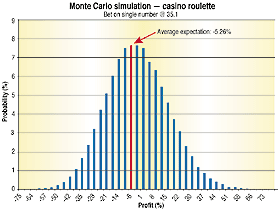SYSTEM DESIGN
Applications To Systematic Trading
Casino Trading
by Phil Abel
The Monte Carlo simulation, a statistical technique used to model the expected outcomes of a random series of events such as a casino game, also has valuable applications in the evaluation of a systematic trading program.
When you think of a successful trader, what comes to mind? Chances are you conjure up the image of a financial sage like Warren Buffett or George Soros, someone who can seemingly gaze into a crystal ball and pick out a winner. Or maybe you picture a commodity pit trader, hardened and wizened from days spent in battle on the exchange floor.
Now what if I told you a successful trader might have the most in common with a casino manager? How can the proud and noble trader possibly lower his self-image to equate it with that of a gambling house? Indeed, the word gambling has a most negative reputation.
Think about the word. According to Webster, "gambling" is defined "to bet on an uncertain outcome." The term does not need to be synonymous with the word "losing," however. After all, the casino industry nets substantial profits every year. Casinos have learned to turn the short-term uncertainty of the casino games into the long-term certainty of profits. If you learn to think like the house instead of like the player, you can turn the trading odds in your favor. An analysis technique called the Monte Carlo simulation can help evaluate trading models in this fashion.
THE ROULETTE WHEEL
Let's start by examining the simple casino game of roulette. The roulette wheel has 38 numbered slots into which a ball may fall -- zero, double zero, and one through 36. We shall focus on betting on a single number. The chance of hitting any one number is 1:38, or 2.63%. The payout when you pick the winning number is 35:1, meaning that you get back $35 for every $1 you wager ($35 plus your $1 bet returned). The odds (35:1) that the casino pays are less than the true odds (38:1) of the particular wager. Paying less than true odds is the means by which the casino makes its profits.
How can the average gambler expect to fare at the roulette tables? Figure 1 shows a distribution of simulated outcomes. We assume that 50,000 random gamblers each play 1,000 consecutive spins of the roulette wheel. They each start with $1,000 and wager $1 on a single number per spin. At the extremes of the curve are a few especially lucky or unlucky individuals who do extremely well or extremely poorly. However, the average gambler is left with a small loss. The house edge for this bet is 5.26% -- over time, the house can expect to win 5.26 cents for every dollar wagered. The longer we play, the more we can expect to lose.

Figure 1: Distribution of simulated outcomes. In this casino roulette example, the house edge is 5.26%. In reality, gamblers fare much worse.
...Continued in the November 2003 issue of Technical Analysis
of STOCKS & COMMODITIES
Excerpted from an article originally published in the November 2003 issue of Technical Analysis of STOCKS & COMMODITIES magazine. All rights reserved. © Copyright 2003, Technical Analysis, Inc.
Return to November 2003 Contents